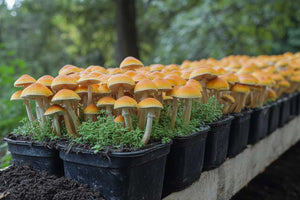In recent times, an increasing number of people have started cultivating mushrooms like shiitake, oyster, enoki, and even psilocybin mushrooms in their own homes.
For those just starting out, a frequent question that arises is: Do mushrooms require light or should they be grown in the dark? And if light is necessary, how much exposure do they need each day?
If you're curious about this, this guide will clarify everything you need to know.
1. Light Requirements for Mushrooms

Mushrooms are fungi, not plants, so they don’t perform photosynthesis. Light is not essential for their growth, and their light requirements are relatively low.
But light does have a certain impact on the growth environment of mushrooms:
1)Color and Shape
Proper light exposure plays a key role in ensuring mushrooms develop an even color and maintain their ideal form. For example, oyster mushrooms achieve a more uniform cap color and balanced stem thickness when exposed to moderate light. Without enough light, mushrooms may become elongated or develop deformities.
2)Growth Speed
Light conditions also influence the speed of growth. Too much light can slow down the process, leading mushrooms to mature prematurely or cease growing altogether. In contrast, moderate light encourages steady, healthy growth.
3)Quality and Taste
Inadequate lighting can result in moisture loss within the mushrooms, negatively impacting their texture and nutritional content. By maintaining the right light levels, mushrooms retain their tenderness and enhance their flavor.
2. Light Needs at Different Growth Stages

Mushrooms go through several key stages, including the spore stage, mycelium stage, and fruiting body stage. At each stage, their light requirements vary:
-
Spore Stage: Almost no light is required, and this can be entirely ignored.
-
Mycelium Stage: Around 4 hours of low light can support healthy mycelium growth, but this is not absolutely necessary.
-
Fruiting Body Stage: At this stage, mushrooms need 4-6 hours of indirect light per day with moderate intensity. Too little light may result in incomplete development, leading to smaller or asymmetrical mushrooms. Too much light may cause brown spots or other physiological problems.
The specific light requirements differ based on the type of mushroom being grown. For instance, enoki, oyster mushrooms, straw mushrooms, and button mushrooms typically need just 4-6 hours of light daily. On the other hand, varieties like shiitake, reishi, lion’s mane, and chanterelles may require 10-12 hours of light each day.
If you'd like more detailed information about other mushroom types, don't hesitate to reach out to us.
3. How to Properly Manage Light for Mushrooms

1)Fixed Duration
Provide a consistent amount of light at set intervals to establish a stable growth cycle. You can use a timer to control a grow lamp for plants, ensuring consistent light exposure every day.
2)Consider Other Environmental Factors
Beyond light, factors like temperature, humidity, and proper ventilation are equally critical for ensuring optimal mushroom growth. Effective light management should work in harmony with these conditions to create the perfect environment for your mushrooms to thrive. Balancing all these elements will lead to healthier, more productive growth.
3)Control Light Intensity
Select a light source with moderate intensity to ensure it's neither too harsh nor too dim. You can control the intensity by using shading cloth or adjusting the distance between the light source and the mushrooms.
For indoor cultivation, natural diffused light is the best option. However, if your space lacks adequate natural light, LED grow lamps are a great alternative. Low-intensity LED lights not only simulate natural sunlight but also protect mushrooms from excessive heat or radiation, creating an optimal growing environment.
Conclusion
Although mushrooms don’t depend on photosynthesis like plants, properly managing light at different growth stages significantly affects their quality. During the "dark phase" at the spore stage, to "gentle light support" at the mycelium stage, and finally "moderate light exposure" during the fruiting body stage, adjusting the light at each step is crucial. By mastering these light conditions, you can easily cultivate well-formed, healthy mushrooms.
FAQ
1. What conditions are needed to grow mushrooms?
1)Suitable temperature (10°C-25°C)
2)High humidity (85%-95%)
3)Organic-rich substrate, such as straw, wood, or corn cobs.
4)Good ventilation.
2. Do mushrooms grow in light or darkness?
Mushrooms grow better in dark or low-light environments.
3. Do I need grow lights to grow mushrooms?
If the lighting at home is not good, you can use a grow light to grow mushrooms. The wattage needs to be lower and the light does not need to be too strong. A small amount of light can promote the growth and development of mushrooms.

